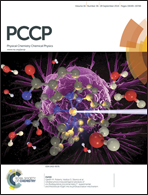Copper–manganese mixed oxides: CO2-selectivity, stable, and cyclic performance for chemical looping combustion of methane†
Abstract
Chemical looping combustion (CLC) is a key technology for oxy-fuel combustion with inherent separation of CO2 from a flue gas, in which oxygen is derived from a solid oxygen carrier. Multi-cycle CLC performance and the product selectivity towards CO2 formation were achieved using mixed oxide of Cu and Mn (CuMn2O4) (Fd![[3 with combining macron]](https://www.rsc.org/images/entities/char_0033_0304.gif) m, a = b = c = 0.83 nm) as an oxygen carrier. CuMn2O4 was prepared by the co-precipitation method followed by annealing at 900 °C using copper(II) nitrate trihydrate and manganese(II) nitrate tetrahydrate as metal precursors. CuMn2O4 showed oxygen-desorption as well as reducibility at elevated temperatures under CLC conditions. The lattice of CuMn2O4 was altered significantly at higher temperature, however, it was reinstated virtually upon cooling in the presence of air. CuMn2O4 was reduced to CuMnO2, Mn3O4, and Cu2O phases at the intermediate stages, which were further reduced to metallic Cu and MnO upon the removal of reactive oxygen from their lattice. CuMn2O4 showed a remarkable activity towards methane combustion reaction at 750 °C. The reduced phase of CuMn2O4 containing Cu and MnO was readily reinstated when treated with air or oxygen at 750 °C, confirming efficient regeneration of the oxygen carrier. Neither methane combustion efficiency nor oxygen carrying capacity was altered with the increase of CLC cycles at any tested time. The average oxygen carrying capacity of CuMn2O4 was estimated to be 114 mg g−1, which was not altered significantly with the repeated CLC cycles. Pure CO2 but no CO, which is one of the possible toxic by-products, was formed solely upon methane combustion reaction of CuMn2O4. CuMn2O4 shows potential as a practical CLC material both in terms of multi-cycle performance and product selectivity towards CO2 formation.
m, a = b = c = 0.83 nm) as an oxygen carrier. CuMn2O4 was prepared by the co-precipitation method followed by annealing at 900 °C using copper(II) nitrate trihydrate and manganese(II) nitrate tetrahydrate as metal precursors. CuMn2O4 showed oxygen-desorption as well as reducibility at elevated temperatures under CLC conditions. The lattice of CuMn2O4 was altered significantly at higher temperature, however, it was reinstated virtually upon cooling in the presence of air. CuMn2O4 was reduced to CuMnO2, Mn3O4, and Cu2O phases at the intermediate stages, which were further reduced to metallic Cu and MnO upon the removal of reactive oxygen from their lattice. CuMn2O4 showed a remarkable activity towards methane combustion reaction at 750 °C. The reduced phase of CuMn2O4 containing Cu and MnO was readily reinstated when treated with air or oxygen at 750 °C, confirming efficient regeneration of the oxygen carrier. Neither methane combustion efficiency nor oxygen carrying capacity was altered with the increase of CLC cycles at any tested time. The average oxygen carrying capacity of CuMn2O4 was estimated to be 114 mg g−1, which was not altered significantly with the repeated CLC cycles. Pure CO2 but no CO, which is one of the possible toxic by-products, was formed solely upon methane combustion reaction of CuMn2O4. CuMn2O4 shows potential as a practical CLC material both in terms of multi-cycle performance and product selectivity towards CO2 formation.


 Please wait while we load your content...
Please wait while we load your content...